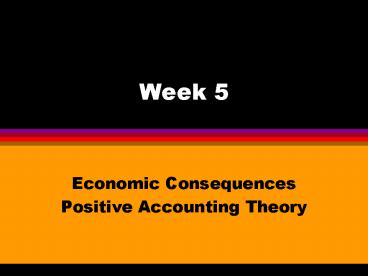Week 5 PowerPoint PPT Presentation
1 / 33
Title: Week 5
1
Week 5
- Economic Consequences
- Positive Accounting Theory
2
General Outline
- Moral Hazard Problem
- Chapter 7 demonstration that accounting policy
matters - Chapter 8 positive accounting theory
- Chapter 9 game theory
3
The Concept of Economic Consequences
- policy choice does matter
- choice of policy can affect firm value
- any policy (e.g., depreciation)
- apparently conflicts with efficient market theory
4
Why should we care?
- Experience shows that firms are concerned about
policy choice - Can look for reasons for the existence of
economic consequences
5
Accounting for foreign exchange conversion
- monetary vs. non-monetary items
- non-monetary items inventories and capital
assets - monetary items cash and a/r, a/p and bonds
payable
6
Temporal Method of Translation
- Non-monetary items translated at historical rate
- Monetary items translated at the closing rate
7
Massey-Ferguson
8
SFAS 52
- functional currency
- current (closing) rate translation
- temporal method used to translate to functional
currency - USfunctional currency for countries with
hyperinflation
9
economic theories of exchange rate determination
- purchasing power parity
- assumes that free trade exists and shipping and
transaction costs are zero - then the purchase price of a bundle of goods
should be the same everywhere. - Therefore exchange rate ratio of (UK price) /
(US price)
10
interest rate parity
- assumes that capital can move freely between
countries, and free foreign exchange markets
exist - Simplest form interest rate differential between
the same-risk instrument held in two different
currencies the expected change in their
exchange rate
11
Which standard is better?
- Relevance ?
- Reliability ?
- Measurement perspective?
12
Collins and Salatka (1993)
13
Accounting for government assistance
- Investment tax credit (1962)
- (1) Can take to PL, reduce current tax
- (2) reduce cost of related capital asset
(amortize over asset life) - (3) liability (deferred ITC) amortized
- (4) 48-52 method. (if tax basis of asset reduced)
14
APB 2
- Required 2 or 3
- Led to conflict with
- FCC - required method (1)
- SEC - allowed method (4)
- APB 4 - allowed method (1)
15
Stock market reaction to policy
- Lev (1979)
- successful efforts (SE) vs. full-cost method
- ED issued on July 18, 1977
- negative return for switch firms on day of ED
issue
16
Questions
6, 10, 13
17
Positive Accounting Theory
- Chapter 8
18
Agenda
- Positive accounting theory
- Audit prices and free cash flow
- Outsider directors and disclosure
- The Asian crisis and disclosure
19
Positive Accounting Theory
- Positive vs. Normative theory
- Contracting costs
- Opportunistic and efficiency forms of the theory
20
Three Hypotheses of PAT
- Bonus plan hypothesis
- Debt covenant hypothesis
- Political cost hypothesis
21
Tests of the Theory
- Healy
- Sweeney
- Jones
- Hong Kong tests
- Gul and Tsui
- Chen and Jaggi
22
Gul and Tsui (Hong Kong Data)
- Free cash flow and audit fees
- Low growth / high FCF firms have more earnings
manipulation problems? - Low growth / high FCF firms issue more debt? (To
improve monitoring of managers) - What can we conclude about how auditors will
charge firms?
23
Low FCF
High FCF
High Debt
Low Debt
Low Growth
Low Fees
High Fees
High Growth
24
Variable Measurement
- Growth
- Market-to-book ratio
- Market-to-total-assets ratio
- PPE/market-value
- Free cash flow
- Operating income
- Depreciation
- - Taxes - interest - dividend payments
- Debt debt / total assets
- Audit fee
25
Tests
- Dependent variable LAF.
- Independent variables.
- Control variables (size, etc. ).
- FCF.
- FCFde.
- Separately for low / high growth firms.
26
Table 8 Summary Regression Results Variables
Predicted sign Model 1 Model
2 INTERCEPT -4.147 -4.275 (-8.875)
(-9.023) FCFBEQ ? 0.917 (2.7
98) FCFBEQDE ? -7.729 (-2.864)
FCFBA ? 1.990 (2.401) FCFBA
DE ? -18.758 (-3.013) N 46
46 R2 75.35 76.06 p-value lt
0.05 p-value lt 0.01 t-value in
parentheses
27
Figure 6 Free Cash Flow, Debt Monitoring and Hong
Kong Audit Prices
Audit Fee
Low Debt
High Debt
Low FCF
High FCF
28
Chen and Jaggi
- The role of non-executive directors
- The relationship between the role of
non-executive directors and disclosure - The impact of family control on this association
- The role of auditors
29
Empirical Evidence from Hong Kong
Association between Independent Non-Executive
Directors, Family Control and Financial
Disclosures (Chen and Jaggi, Journal of
Accounting and Public Policy)
- Proportion of non-executives (NEDs) on corporate
boards - more corporate disclosures - Family ownership affects role of corporate
governance - Whether family control of the firm has an impact
on NED/disclosures association - Family owned firms - non-executive directors are
likely to be less effective - Family members are likely to appoint
non-executive directors who are supporters of
management
30
Chen and Jaggi collected data (1993 1994) from
Hong Kong used the following regression Disclo
sure Scores (Non-Executive Directors (NED),
Family Ownership(FO), NED x FO, Control
Variables)
Corporate disclosure measured by instruments
developed by Wallace and Naser (1995) 30 major
disclosure items relating to Income Statements,
Balance Sheets, Notes to Financial Statements,
Chairmans Statements etc. Family control(dummy
variable 1 family owned gt 10 ownership 0
otherwise)
31
Summary Regression Results
Family Non-Family All Firms Controlled
Controlled ? 0.507 0.520 0.603
(12.176) (12.408) (6.831) NED 0.279
-0.011 0.515 (3.181)
(-0.299) (5.386) NEDFO -0.267 (-2.770) N 17
4 136 38 Adjusted R2 0.300
0.402 0.516 p lt
0.05 (two-tailed) p lt 0.01 (two-tailed)
t-values in parentheses
32
Figure 3 Regression Results for Corporate
Disclosures, Non-Executive Directors and Family
Ownership.
Ownership Structure of Hong Kong Companies
Family Owned
Non-Family Owned
High Non-Executive Directors
Low Non-Executive Directors
High Non-Executive Directors
Low Non-Executive Directors
No difference in corporate disclosure
Significant difference
More corporate disclosure
33
Questions
5, 6, 7, 8
Professor Guls public lecture

